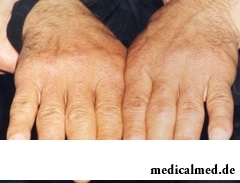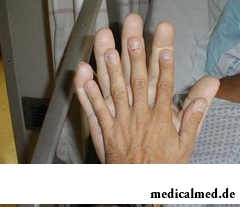





Acromegalia
General characteristic of a disease

Acromegalia, it in use giantism – a serious neuroendocrinal disease. It is caused by hypersecretion of hormone of Somatotropinum, a so-called growth hormone.
Giantism it is accepted to call an acromegalia at patients of children's and teenage age. The increased development of Somatotropinum at them leads to excess linear growth. At patients of adult age growth of soft tissues and a periosteum, and also an excessive set of weight is characteristic of an acromegalia.
The acromegalia develops in 99% of cases as a result of hypophysis adenoma. At an acromegalia there is a pathological increase in all internals of the person: hearts, lungs, spleen, liver, intestines and pancreas. Their hypertrophy is fraught with a sklerozirovaniye of fabrics and development of multiorgan insufficiency. Besides, the patient with symptoms of an acromegalia has an increased probability of formation of kind and malignant tumors.
The acromegalia meets on average at 50 on 1 million people. The sex of the patient of a role does not play. Most often adenoma of a hypophysis and an acromegalia as its investigation, are diagnosed for people of 40-60 years.
Acromegalia reasons
The prevailing number of cases of the diagnosed acromegalia results from pure somatotropic adenoma (it is a somatotropinoma). The acromegalia can be also combined. Supersecretion of Somatotropinum and prolactin or Somatotropinum and other kinds of adenogipofizarny hormones is the reason of adenoma of this type.
So among the reasons of an acromegalia call pathologies of secretion of hormones:
- TTG (thyritropic hormone),
- LG (luteinizing hormone or lyuteotropin),
- FSG (follicle-stimulating hormone),
- and - subunits, etc.
As the acromegalia reason in most cases serve mutations of somatotrof. So the special type of a secretory granule of a hypophysis is called.
The acromegalia can also develop as a result of MEN-1 syndrome (a multiple endocrine neoplasia). Formation of numerous tumors in a hypophysis, thyroid and thymic glands, adrenal glands, a nervous system and digestive tract is characteristic of this disease of a hereditary etiology.
Acromegalia symptoms
Symptoms of an acromegalia have slow rate of increase. On average at adult age the disease is diagnosed only 10 years later after manifestation of the first symptoms of an acromegalia.
Refer appearance changes to the main symptoms of an acromegalia. Exactly thanks to them – coarsening of features, increase in malars, superciliary arches, a mandible – the person can have a suspicion about existence of a disease at it.
Soft tissues at the patient with symptoms of an acromegalia are hypertrophied: language, ears, a nose, lips, brushes and feet are slightly increased. During further progressing of a disease there is a change of a bite due to growth of interdental spaces.

At patients of children's and teenage age the main symptom of an acromegalia is the excessive rate of linear growth advancing all age norms.
Among additional symptoms of an acromegalia call:
- arthralgia (excess formation of cartilaginous tissue),
- the increased perspiration and excessive activity of sebaceous glands,
- consolidation of an upper layer of skin,
- splanchnomegaly (increase in a spleen)
- the degeneration of muscle fibers causing decrease in working capacity and small physical activity.
Chronic hyperproduction of Somatotropinum at an acromegalia can result in multiple multiorgan insufficiency. A symptom of an acromegalia of a late stage of development is the myocardium hypertrophy, heart failure and the increased intracranial pressure.
The apnoea syndrome – the threat of an apnoea in a dream caused by growth of tissues of airways is diagnosed for 90% of patients with symptoms of an acromegalia.
Acromegalia – also the reason of erectile dysfunction at men and disturbances of a menstrual cycle at women of childbearing age.
Diagnosis of an acromegalia
The acromegalia is diagnosed on the basis of data of a blood analysis on the IRF-1 level (somatomedin C). At normal indicators carrying out the provocative test with loading glucose is recommended. For this purpose at the patient with suspicion of an acromegalia blood sampling each 30 minutes 4 times a day is made.
For visualization of the reason of an acromegalia - adenoma of a hypophysis brain MRT is carried out. In diagnosis of a disease also the exception of possible complications of an acromegalia is important: diabetes mellitus, polypose of intestines, heart failure, craw, etc.
Treatment of an acromegalia
Main objective of treatment of an acromegalia – normalization of development of Somatotropinum. For this purpose to the patient surgical removal of adenoma of a hypophysis is carried out. The operational treatment of an acromegalia provoked by tumors of the small sizes in 85% of cases leads to normal secretion of hormones and to permanent remission. Surgical treatment of the acromegalia caused by a tumor of a hypophysis of the large sizes is effective only in a third of cases.

In conservative treatment of an acromegalia antagonists of Somatotropinum – artificial analogs of hormone of somatostatin are applied: Lanreotid and Oktreotid. Thanks to their regular use for 50% of patients it is possible to normalize the level of hormones, and also to cause reduction of the sizes of a tumor of a hypophysis.
It is possible to reduce synthesis of a growth hormone also reception of blockers of receptors of somatotrof, for example, by Pegvisomantom. This technique of treatment of an acromegalia still needs additional studying.
Beam treatment of an acromegalia is considered inefficient as an independent method of therapy and can be applied only as a part of complex measures of fight against a disease.
Except people, only one living being on the planet Earth – dogs suffers from prostatitis. Here really our most loyal friends.

Household skills which to us so diligently imparted in the childhood it appears, not always bring only benefit. According to result...
Section: Articles about health
The state of health of the person depends on many factors. One of the most important is the constant, but not exhausting a physical activity. In the presence of various illnesses specialists often advise patients to do swimming which by right borrows ведущ...
Section: Articles about health
Practically each person is familiar with the annoying, pulling, unscrewing pains caused by overcooling of muscles of a back. In certain cases inflammatory process is not limited to discomfort, being followed by emergence of hypostasis, consolidations, temperature increase. At the wrong treatment the acute miositis can lead to a chronic disease or aggravation of other pathologies of a back (vertebral hernia, osteochondrosis) therefore it is important to pay attention to symptoms of an illness in time and to start to...
Section: Articles about health
Cold, puffiness of a nose, itch, the watering eyes - characteristic symptoms of the allergic rhinitis resulting from hit and...
Section: Articles about health
All like to sing. Small children with pleasure are engaged in a vocal, not especially thinking of hit in a melody. Adults most often hesitate, being afraid to show lack of talents in this area, and it is vain: singing is very useful for health....
Section: Articles about health
The sudden heat on all body which is followed by perspiration and a cardiopalmus – the phenomenon familiar to many people. Most often such states called by "inflows" result from nervous or physical overworks and disappear right after rest. However in certain cases similar reaction of an organism can speak about diseases which need treatment. What? About it below....
Section: Articles about health
With age in a human body harmful substances collect. We receive them with food and water, at inhalation contaminated air...
Section: Articles about health
Popular joke that there are no healthy people, and is nedoobsledovanny, most of us considers an honest truth, continually it is necessary to hear that all of us are sick hardly from a school bench. It is hard to say, whether so it actually because...
Section: Articles about health
Weakness of an ankle joint – very widespread problem. Its existence is demonstrated by tendency to a podvorachivaniye of legs when walking on heels, frequent painful sprains, pain on average and anonymous toes even after small loadings. Usually people with such pathology take off unpleasant effects by means of the anesthetizing pulverizing and ointments, but it does not lead to radical elimination of a problem. Meanwhile, at the known persistence it is possible to strengthen an ankle to the house...
Section: Articles about health
Antibiotics - - it is possible to call the chemical compounds suppressing growth of bacteria the break in the field of medicine which allowed to save persons...
Section: Articles about health
About 10-15 years ago existence of the computer in the apartment of the Russian was considered as a rarity and office rooms were only at the first stage of equipment by these useful devices. Today practically in each house there is a computer (and often not one), and to constants...
Section: Articles about health
The problem of diagnosis was and remains to one of the most important in medicine. From that, the reason of an indisposition of the patient will be how precisely defined, eventually success of treatment depends. In spite of the fact that the majority of the diagnostic methods applied in official clinical practice has very high informational content and reliability, mistakes directed by diagnoses nevertheless are not excluded....
Section: Articles about health
The main role in development of a peptic ulcer of a stomach and duodenum the bacterium Helikobakter plays pilor. Activity and Wuxi...
Section: Articles about health
On health of the person physicians know about salutary action of animals long ago. About 7 thousand years ago great Hippocrates recommended to the patients riding walks for strengthening of a nervous system and increase in vitality....
Section: Articles about health
The advantage of swimming for the person is so high that this sport is not only the most popular, but also is widely applied in medicine and rehabilitation processes. If you look for for yourself the occupation allowing pleasantly and to spend time, then swimming with advantage – the fact that it is necessary for you. And give learns several facts about swimming....
Section: Slideshow
Striya (extension) are the defects of skin having an appearance of direct or wavy strips from 1 to 10 cm long and 1-5 mm wide. In the majority with...
Section: Articles about health
There is an opinion that at low temperatures safety of products is ensured longer and better thanks to what the refrigerator is considered the most suitable place for storage of food. In most cases it is fair, however there is a number of products, for a kotor...
Section: Articles about health
There is a lot of fans of beer in our country. Statistically, on each average Russian (including women and children) in a year about 60 liters of this drink are consumed. It is not a lot of, as in the Czech Republic or Germany, but figure all the same impressive. There is nothing to rejoice here: despite assurances of producers that beer is absolutely harmless, effects of its active consumption cannot be considered positive in any way. Here only part of that negative impact, which popular нап...
Section: Articles about health
The summer of this year in Russia was very ambiguous. Regions suffered from a merciless heat, from pouring rains, from times...
Section: Articles about health
The concept "gluten" (differently, a gluten) combines group of the proteins which are a part of rye, barley and wheat. For most of people the use of the food stuffs containing a gluten not only is safe, but also it is very useful. Nevertheless, there is a number the myth...
Section: Articles about health
Each person knows that fervescence is an illness sign. However too low temperature (hypothermia), especially also can demonstrate existence of diseases when it is observed long enough. Such state is dangerous that it, unlike fever, does not give a serious inconvenience: patients usually complain only of weakness, drowsiness, apathy. Sometimes the fever and a cryesthesia in extremities joins. Many people at similar symptoms...
Section: Articles about health
About influence of fasting days on an organism it is told much – both about advantages, and about shortcomings. It is considered that fasting day...
Section: Articles about health
Run - one of the most available and effective ways to revitalize the organism. Knowing about its extraordinary advantage, each of us at least once tried to make jogs, but only the few made these occupations regular. In spite of the fact that in jogging (easy an ozdor...
Section: Articles about health
Wood louse – the ordinary-looking unpretentious plant extended in all territory of our country. It quickly expands, and sometimes fills sites, bringing a lot of chagrin to gardeners. Perhaps, they would be upset less if knew that the wood louse is valuable medicinal raw materials. A, C and E vitamins, organic acids, tannins, wax, saponins, lipids, mineral salts and essential oils are its part....
Section: Articles about health
Transfusion of donor blood has almost century history. In spite of the fact that this procedure is quite usual for many people, itself п...
Section: Articles about health
Herpes simplex of the first type (the infectious disease which is shown periodic bubble rashes on lips is called) – one of the most widespread illnesses. Statistically, only 5% of inhabitants of our planet are unreceptive to its activator, and...
Section: Articles about health
Almost each of us during life faced dissatisfaction with own body. At such moments, as a rule, we begin to shame ourselves, urgently we go on the most rigid diet promising minus of 10 kg in a week, or we exhaust ourselves in the gym to almost death. As a rule, similar attempts come to an end with a campaign to the refrigerator for jamming of the next stress. Further history repeats itself with individual frequency....
Section: Articles about health
